10 Starfish Species You Can Find In California
California is an excellent spot for snorkeling and diving. You can spot there many different species of marine animals when underwater. Starfish, or sea stars, are definitely one of the most popular and easiest animals to spot in shallow waters. Have you wondered if and which species of starfish can you spot in California? In this blog post, we’ll talk all about that but let’s begin with a quick answer:
In California, you can find many different starfish species such as Ochre Sea Star, Sunflower Sea Star, Bat Star, Giant Sea Star, Pink Sea Star, Spiny Sand Star, Spiny Sea Star, Morning Sun Star, Rainbow Star, Spiny Red Star, and more.
However, this certainly doesn’t tell the whole story. Below I’ll explain how to identify each species, and where to find them. Furthermore, I’ll explain why starfish are in California and whether you can pick them up or not. Read on!
Starfish species in California
There are many different species of starfish in California, and below you’ll find a short description of 10 popular species from this region. You can learn how to identify them quickly and where else in the world you can find them.
Ochre Sea Star (Pisaster Ochraceus)
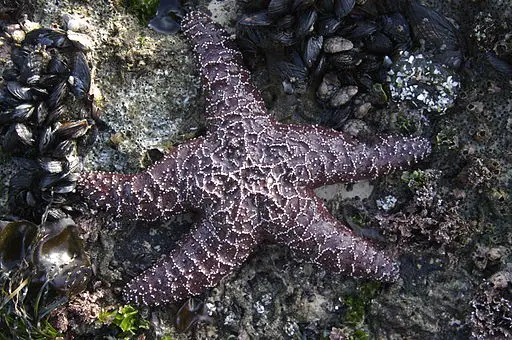
Orche sea stars (also known as purple sea stars) are very common starfish in the Pacific Ocean, including California. As the name suggests, most individuals are purple, but some can be orange, pinkish, yellow, reddish, or brown. Their underside surface is usually pale orange in color.
They have five arms, and, like all other starfish, their upper surface is covered in small spines. Ochre sea stars have spines arranged in a netlike pattern on the central disk, making their identification easier. They usually grow to about 14 in (36 cm) in diameter.
These species live in the lower inter tidal zone at depths to a maximum of 90 m. They prefer rocky shores where they can stay close to mussels and barnacles which are their favorite food.
Interestingly, ochre starfish were the first animals identified as the keystone species. In 1966, Robert Treat Paine, a groundbreaking ecologist, wanted to prove how different organisms co-exist in their environment. He removed ochre sea stars from the coastline and noticed that the food web had become completely unbalanced.
Starfish were the only animals that ate mussels, so the mussels completely took over, driving out all other species on the studied coastline. This experiment proved that starfish are truly essential to the ecosystem, which is why they’re classified as keystone species.
Read more about it in my other article: “Are Starfish Keystone Species?”.
Other places to spot it: Coastline from Alaska to California.
Sunflower Sea Star (Pycnopodia Helianthoides)

Sunflower sea stars are the largest sea stars in the world. They can grow to about 3.3 ft (1 m) in diameter and have even 24 arms! Their color ranges from bright orange, yellow-red, brown to purple. They’re also one of the quickest starfish and can move at a speed of 3.3 ft/min (1 m/min).
Unfortunately, these species are currently endangered due to the sea star wasting disease and rising water temperatures (climate change). Their population rapidly declined between 2013–2015 to about 80–100%, depending on the region. Now, it can be very rare to spot them in California.
Other places to spot it: It used to be common in the northeast Pacific from Alaska to southern California but currently it’s very rare.
Bat Star (Patiria Miniata)
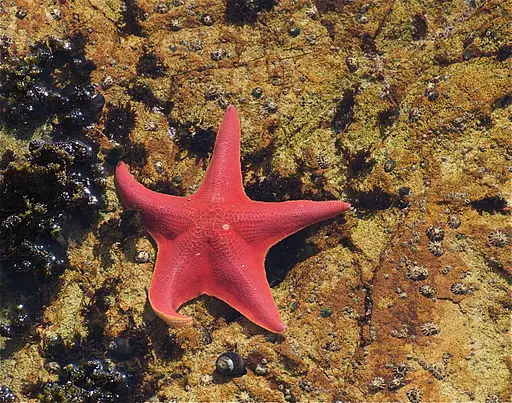
Bat stars get their unique name from the webbing between their arms (rays) that resemble bat’s wings. They typically have five short arms but occasionally have four, six, or more. Their center disk is wider than their arms, and their body is thick.
Bat sea stars’ upper bodies can have solid color but very often have a colorful pattern that varies in color a lot. They can be green, purple, red, orange, yellow, or brown, with the oral side (underside) mostly being pale yellow.
The bat stars usually live in the intertidal and subtidal zones to a depth of 980 ft (300 m). Their perfect habitat is rocky shores, sandy bottoms, sea grass, and kelp forests.
Other places to spot it: from Sitka, Alaska to Baja California in the Pacific Ocean.
Giant Sea Star (Pisaster Giganteus)
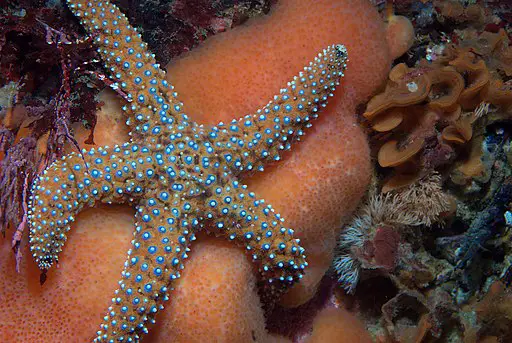
Giant sea stars can be indeed large but they didn’t get this name because of the size of their body. They got this name because of the giant, thick spines covering their bodies. Additionally, these spines are intense blue in color with white, pink, or purple tips.
The rest of their bodies’ color ranges from brown to red or purple. They can grow to about 24 in (61 cm) in diameter which still makes them pretty large starfish. They usually have five arms but sometimes they can be found with six.
Giant sea stars live in protected coastal areas but also inhabit deeper waters and kelp forests.
Other places to spot it: The western coast of North America from Southern California to British Columbia.
Pink Sea Star (Pisaster Brevispinus)
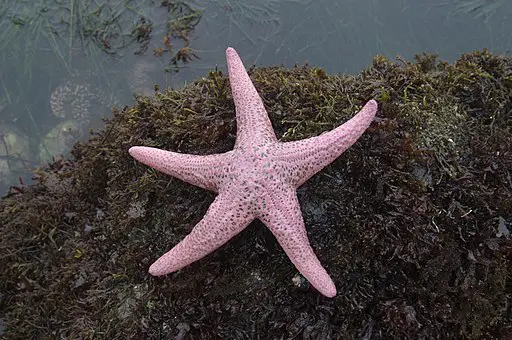
Pink sea stars are sometimes also called giant pink sea stars, and they’re another large starfish on the Pacific coast. They typically grow to about 13 in (33 cm) in diameter, but some individuals were found that have about 35 in (90 cm).
As the name suggests, they’re typically pink, sometimes with shadings of gray. On the oral side of their bodies, they have four rows of pretty long, tube feet that help them move around, capture food, and breathe. They normally have five very thick arms.
These species like relatively shallow waters, and we can mostly find them at depths up to 360 ft (110 m). They mostly live on sandy or muddy bottoms in protected bays where they can find their favorite food – clams. Interestingly they can even locate them buried in the sand and dig down to eat them.
Other places to spot it: The coast of North America from Sitka in Alaska to California.
Spiny Sand Star (Astropecten Armatus)
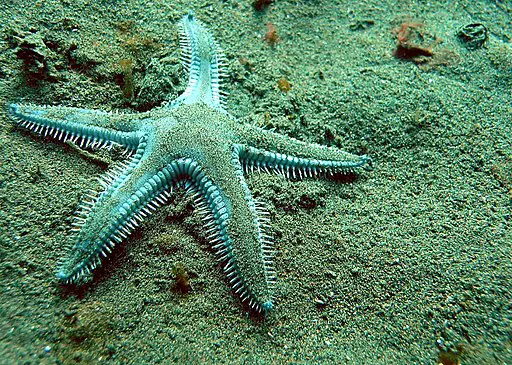
Spiny sand stars are dorsally flattened and have a pretty smooth surface. They can grow to a diameter of about 7 in (17 cm) and typically have five arms with tips slightly pointed up, right where their eyes are located. As the name suggests, they got their name for two reasons.
Firstly, the margins of their arms are lined with characteristic spines pointing up. They also have very long tube feet underside their bodies, and as you can see in the picture, they’re slightly lighter than the rest of their gray body. These spines help them to burrow in the sand where they live.
Secondly, they’re called “sand” sea stars because they inhabit sandy bottoms. Their body adapted so well thanks to the combination of their spines and color, which is great for camouflage. It’s difficult to see them because most of their time they spend buried in the sand where they hide from predators.
Other places to spot it: Sandy areas ranging from California to Ecuador.
Spiny Sea Star (Poraniopsis Inflata)
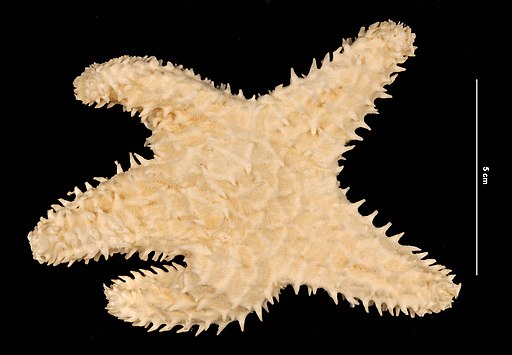
Spiny sea stars have five short arms and many pointy spines with white tips on the aboral (upper) surface. Their skin color is usually orange but can also be brownish-white or white, marked with violet. They’re small sea stars and typically grow to a diameter of about 6.3 in (16 cm).
Other places to spot it: Deep waters from Alaska to California.
Morning Sun Star (Solaster Dawsoni)
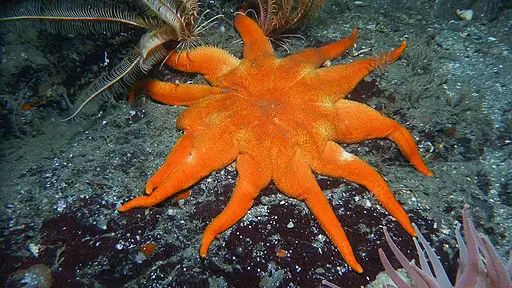
Morning sun stars have a wide disc and very long, tapering arms. They can grow about 8 to 13 arms, and their body size is usually about 16 in (40 cm) in diameter. Their upper surface is smooth, and their color ranges from red to orange, grey, or pale brown.
Interestingly, these starfish are very aggressive predators and mainly prey on other starfish. Their favorite one is the leather sea star because of its slow movements. Other sea stars, such as rainbow stars, usually fight back. Furthermore, morning sun stars sometimes chase even bigger starfish, like sunflower sea stars.
Sunflower sea stars very often dramatically escape when touched by morning sea stars. Sometimes they sacrifice one of their arms and shed it by the process called autonomy.
Other places to spot it: The Pacific Ocean, from Alaska to California, and the north coast of Asia such as Japan, China
Rainbow Star (Orthasterias Koehleri)
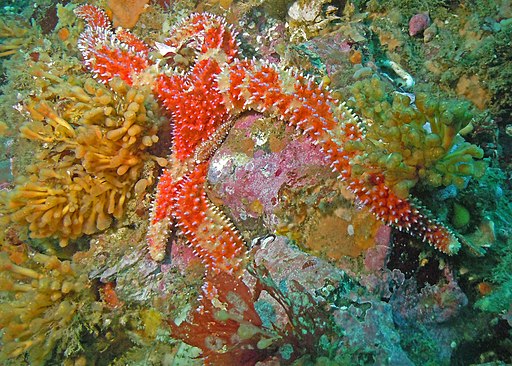
Rainbow sea stars, as the name suggests, are very colorful starfish, and their color ranges from bright orange, red, and purple to pink. They have five long, tapering arms and usually grow to a diameter of 20 in (50 cm). The spines on their upper body are sharp, pointy, and white in color.
These species usually inhabit subtidal zones at depths of about 820 ft (250 m) but also shallower intertidal zones. They’re found on rocky bottoms but also on soft surfaces of sand or mud.
Other places to spot it: Northern parts of the Pacific Ocean, from Alaska to California.
Spiny Red Star (Hippasteria Phrygiana)
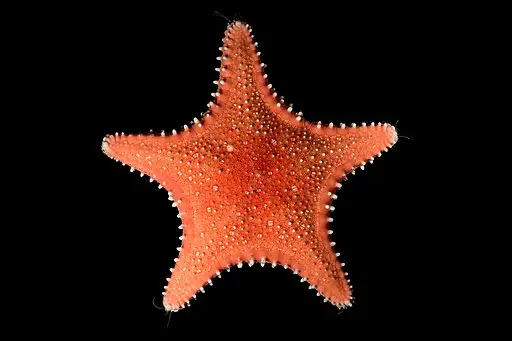
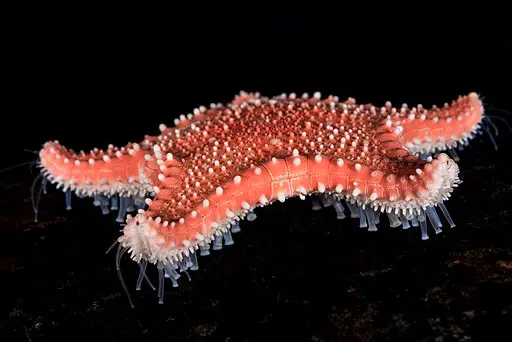
Spiny red stars are indeed red on the aboral side and pale pink on the oral side, and their surface is fully covered with large sharp spines. These sea stars can grow to about 13 in (34 cm) in diameter. Red spiny sea stars prefer colder and deeper waters to depths of about 1640 ft (500 m).
Other places to spot it: Alaska to southern California but also the Okhotsk sea.
Where can you spot starfish in California?
California has excellent conditions for many starfish species. Different species adapted to slightly different environments, so you can find them in many different places in California. As saltwater species, they’re of course found in the ocean, so don’t search for them in the lakes.
Some starfish live on sandy bottoms close to shore, and others in rocky tide pools. California is known for having many tide pools, and you can find many starfish species described above. Here are a few examples:
- Royal Palms State Beach Tide Pools, San Pedro,
- White Point Beach, San Pedro,
- Natural Bridges State Beach Tide Pools, Santa Cruz,
- Asilomar State Beach/Point Pinos Tide Pools, Pacific Grove,
- Tide Pools at Pigeon Point Light Station,
- Fitzgerald Marine Reserve Tide Pools,
- and much much more!
Remember to look for them carefully because sometimes starfish hide under rocks or bury themselves in the sand so you can accidentally miss them.
Why starfish are in California?
Starfish are in California simply because of the great conditions. Starfish inhabit many different places such as rocky shores, tropical coral reefs, tidal pools, mud, sandy sea floors, and seagrass meadow and California has many of them. Many starfish species prefer tropical, shallow, and warm waters but there are also species that prefer colder waters.
In California, you can find species that live all the way to Alaska and many of the species are found only in those regions.
Can you pick starfish up?
Even though most starfish are not poisonous, you should never touch or pick them up. Starfish breathe through their skin by absorbing oxygen from the water. They can “hold their breath” for about 30 seconds or less. Removing them can simply cause them to suffocate and die.
Another reason not to touch them is that our skin oil or sunscreen can harm them and all sea creatures. We can transform the bacteria that they’re not immune to. Additionally, starfish can potentially feel stress and pain.
Sources
- Ochre Sea Star Image: Jerry Kirkhart from Los Osos, Calif., CC BY 2.0 https://creativecommons.org/licenses/by/2.0, via Wikimedia Commons
- Sunflower Sea Star Image: Sam Wilson, CC BY-SA 2.0 https://creativecommons.org/licenses/by-sa/2.0, via Wikimedia Commons
- Bat Star: Sam Wilson, CC BY-SA 2.0 https://creativecommons.org/licenses/by-sa/2.0, via Wikimedia Commons
- Giant Sea Star: Ed Bierman from CA, USA, CC BY 2.0 https://creativecommons.org/licenses/by/2.0, via Wikimedia Commons
- Pink Sea Star: jkirkhart35, CC BY 2.0 https://creativecommons.org/licenses/by/2.0, via Wikimedia Commons
- Spiny Sand Star: Ed Bierman from CA, usa, CC BY 2.0 https://creativecommons.org/licenses/by/2.0, via Wikimedia Commons
- Rainbow Sea Star: Oregon Department of Fish & Wildlife, CC BY-SA 2.0 https://creativecommons.org/licenses/by-sa/2.0, via Wikimedia Commons
- Spiny Sea Star: Katie Ahlfeld, CC0, via Wikimedia Commons
- Morning Sun Star: Jonathan Martin, CC BY 2.0 https://creativecommons.org/licenses/by/2.0, via Wikimedia Commons
- Spiny Red Star: Espen Rekdal / Espen Rekdal Photography, CC BY 4.0 https://creativecommons.org/licenses/by/4.0, via Wikimedia Commons
You may also like:

Welcome to Bubbly Diver!
I’m glad to see you here. This blog is created for all marine creature lovers by a bubbly diver - me, Dori :)


